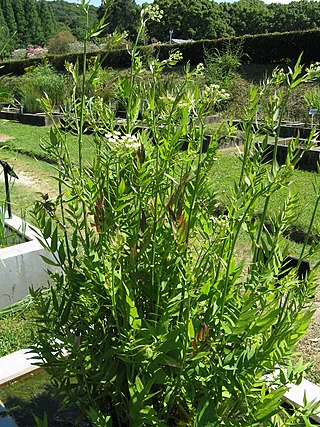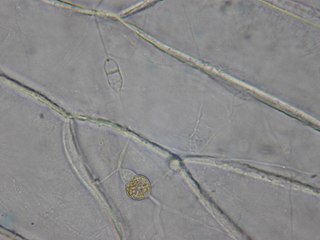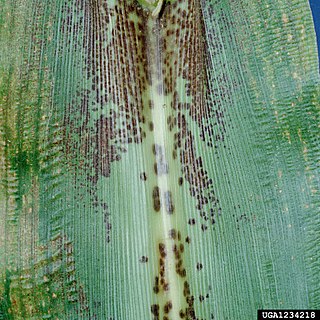
A legume is a plant in the family Fabaceae, or the fruit or seed of such a plant. When used as a dry grain, the seed is also called a pulse. Legumes are grown agriculturally, primarily for human consumption, for livestock forage and silage, and as soil-enhancing green manure. Well-known legumes include beans, soybeans, chickpeas, peanuts, lentils, lupins, grass peas, mesquite, carob, tamarind, alfalfa, and clover. Legumes produce a botanically unique type of fruit – a simple dry fruit that develops from a simple carpel and usually dehisces on two sides.
Pleospora alfalfae is a plant pathogen infecting alfalfa.
Stemphylium alfalfae is a plant pathogen infecting alfalfa.
Xanthomonas alfalfae is a species of bacteria.
Physoderma trifolii is a plant pathogen infecting red clover.

Blastocladiomycota is one of the currently recognized phyla within the kingdom Fungi. Blastocladiomycota was originally the order Blastocladiales within the phylum Chytridiomycota until molecular and zoospore ultrastructural characters were used to demonstrate it was not monophyletic with Chytridiomycota. The order was first erected by Petersen for a single genus, Blastocladia, which was originally considered a member of the oomycetes. Accordingly, members of Blastocladiomycota are often referred to colloquially as "chytrids." However, some feel "chytrid" should refer only to members of Chytridiomycota. Thus, members of Blastocladiomyota are commonly called "blastoclads" by mycologists. Alternatively, members of Blastocladiomycota, Chytridiomycota, and Neocallimastigomycota lumped together as the zoosporic true fungi. Blastocladiomycota contains 5 families and approximately 12 genera. This early diverging branch of kingdom Fungi is the first to exhibit alternation of generations. As well, two (once) popular model organisms—Allomyces macrogynus and Blastocladiella emersonii—belong to this phylum.

Sium suave, the water parsnip or hemlock waterparsnip, is a perennial wildflower in the family Apiaceae. It is native to many areas of both Asia and North America. The common name water parsnip is due to its similarity to parsnip and its wetland habitat. The alternate common name hemlock waterparsnip is due to its similarity to the highly poisonous spotted water hemlock.
The University of Michigan Herbarium is the herbarium of the University of Michigan in Ann Arbor, Michigan, in the United States. One of the most-extensive botanical collections in the world, the herbarium has some 1.7 million specimens of vascular plants, algae, bryophytes, fungi, and lichens, and is a valuable resource for teaching and research in biology and botany. The herbarium includes many rare and extinct species.

Physoderma is a genus of chytrid fungi. Described by German botanist Karl Friedrich Wilhelm Wallroth in 1833, the genus contains some species that are parasitic on vascular plants, including P. alfalfae and P. maydis, causative agents of crown wart of alfalfa and brown spot of corn, respectively. Of the chytrid genera, Physoderma is the oldest. However, species were confused with the rust fungi, the genus Synchytrium, and the genus Protomyces of Ascomycota. Members of Physoderma are obligate parasites of pteridophytes and angiosperms. There are approximately 80 species within this genus.
Frederick Kroeber Sparrow was an American mycologist. He was known for his research on aquatic fungi, and in particular the genus Physoderma, and he produced a well-received monograph in 1943 titled The Aquatic Phycomycetes Exclusive of the Saprolegniacea and Pythium; this was republished in 1960 as Aquatic Phycomycetes.
Verticillium alfalfae is a fungus. It causes verticillium wilt in some plant species, particularly alfalfa. It produces yellow-pigmented hyphae and microsclerotia, while producing resting mycelium. It is most closely related to V. albo-atrum and V. nonalfalfae.
Streptomyces silaceus is a bacterium species from the genus of Streptomyces which has been isolated from an equine placenta in Lexington in Kentucky in the United States.
Streptomyces alfalfae is a bacterium species from the genus Streptomyces which has been isolated from rhizosphere soil from an alfalfa field in Jingyang in China.

Cladochytrium is a genus of fungi. It is the type genus of the family Cladochytriaceae.

Physoderma maydis is a species of fungus in the family Physodermataceae. It is a pathogen of the maize, causing a disease known as brown spot of maize or brown spot of corn. This species was first labeled in 1910 in India, then again a year later in Illinois.

Eunotia is a genus of diatoms. They are fresh water diatoms, specifically common in lakes, and they are also common in fossil records, although their siliceous wall design may have been lost and they appear plane, an example is Eunotia tetradon.

Mandayam Jeersannidhi Narasimhan was a pioneering Indian plant pathologist and mycologist who worked in the state of Mysore.
Iconella is a genus of braconid wasps in the family Braconidae. There are about 38 described species in Iconella, found throughout most of the world.
Synaldis is a genus of insects belonging to the family Braconidae.

Physodermatacae is a family of chytrid fungi in the order Physodermatales. Species in the family have a parasitic relationship with the host's physoderma. This family is distinctive in that it contains a thick wall around the sporangia to resist against unfavorable conditions. Sporangia releases from a host plant when rotting, dispersal is carried through the air. This family is not to be confused or related to basidiomycetes rusts and smut fungi. This parasite is distributed all across the world in aquatic, semi aquatic wetlands and in some ferns.









